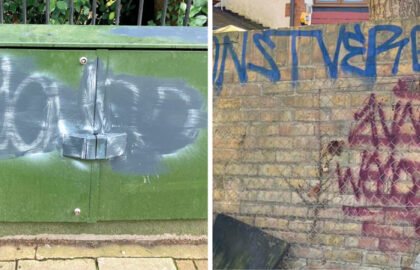Vanya Marks of Wanstead Climate Action talks to a local resident about her DIY efforts to make her flat more energy efficient, something that will reduce her utility bills and help reduce carbon emissions
With the energy crisis and rising cost of living causing us all to tighten our belts, there has never been a better time to upgrade our homes to make them more energy efficient. One out of every four pounds spent on heating is wasted and housing contributes 14% of the UK’s carbon emissions. So, I spoke to a Wanstead resident (who wishes to remain anonymous, so we’ll call her Coni) about how she decided to solve some of these issues herself.
The bedroom wall of Coni’s chilly ground-floor flat is a single-skin wall backing onto a communal entrance corridor, which is unheated and just as cold as outside. So, she decided to fit internal insulation to create a warmer feel to the room and save energy and money. “I also thought it would be a manageable and satisfying DIY job!” said Coni.
Coni bought three boards of 55mm thick insulated plasterboard from Wickes (£68 each). “I could have gone for thinner insulation but I figured I was only going to do this job once so I may as well do it properly. Wickes deliver, which is great as these boards are 2,400mm x 1,800mm and are too big to get in a car.” Coni enlisted her 78-year-old dad to help as the boards were too large for her to manoeuvre into the flat by herself.
“The actual job was quite straightforward. I peeled back the carpet and underlay and prised off the skirting. Then I placed a thin piece of wood on the floor; this ensures the plasterboard is kept off the floor by a couple of centimetres in case of rising damp (this is removed once the boards are fixed). Next, I rested the plasterboard against the wall so I could scribe with a pencil which bits to cut. The corners of the room are not quite true, so I needed to use a handsaw to cut the board to the right shape. It cuts really easily. Then came the fun part – I put the board on the floor again and squirted adhesive foam on the insulated side. I left it for five minutes to expand and go tacky (otherwise it just slides off when you lift the board up) and then held the board in place on the wall for a couple of minutes while it cured. I used a plumb line to make sure the board was vertical. Same procedure for the remaining boards. I then pinned the boards in place by drilling one hole per board and banging in a pin – these anchor the boards to the wall in case of fire, which could cause the boards to fall and block your escape route. To finish, I used a ready-mix filler to fill the gaps between the boards. I painted with dilute PVA (wood glue) to seal the plasterboard, then straight on with the Dulux. I glued the skirtings back on, then cut the carpet back to fit.”
Coni’s room immediately felt warmer and she has created a healthier environment. “I recommend anyone reasonably competent with a drill and saw to have a go.”
The products
Boards: www.wickes.co.uk/Knauf-XPS-Laminate-Plus-Insulated-Plasterboard-Tapered-Edge—55mm-x-1-2m-x-2-
Foam: www.toolstation.com/soudal-genius-gun-plasterboard-adhesive-foam
Pins: www.screwfix.com/p/timco-insulation-fixings-140-x-8mm-100-pack/232kf
The job cost about £300 and took about three days.




